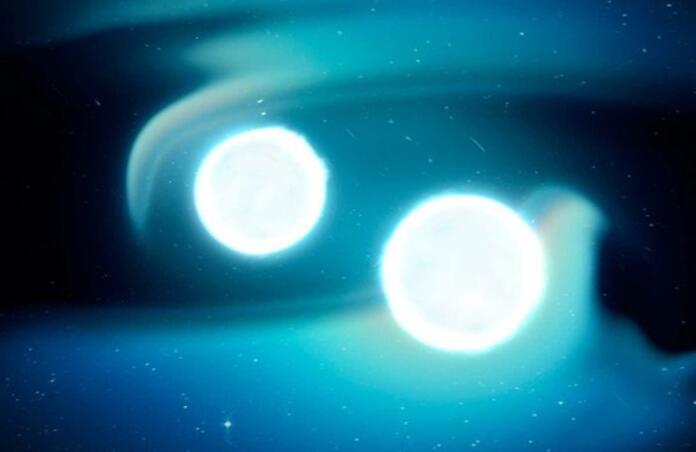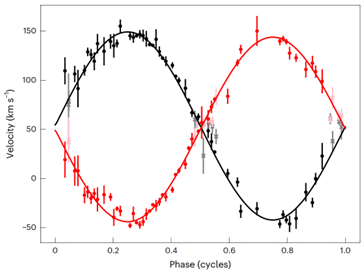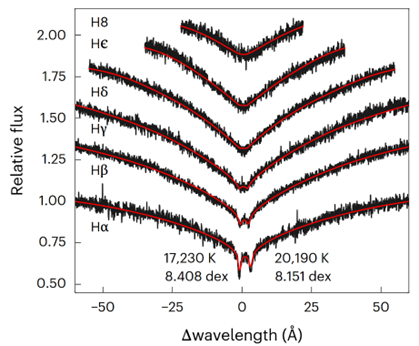Discovery of White Dwarf Binary Fated for Double-Detonation Event

Type Ia supernovae are a crucial class of astronomical events in the study of cosmology, due to their use as standard candles. The single detonation mechanism describes a binary star system wherein one star is a white dwarf. This star can then feed off the mass of its companion, until it reaches the Chandrasekhar limit, the stellar mass at which electron pressure within the core is unable to maintain hydrostatic equilibrium, leading to a core collapse under gravity and an eventual supernova explosion. As these events occur with stars near this mass limit, we are able to assume that all such novae will exhibit the same intrinsic luminosity, allowing their observed brightness to be used to determine how far away the event has occurred.
However, in more recent years, this mechanism has been called into question, and indeed, competing theories have been proposed. Now, a new study presents the first detection of a binary system with a slightly different fate. In their paper, James Munday et al. present the discovery of the stellar binary, WDJ181058.67+311940.94 (henceforth WDJ181058), containing two white dwarves. This novel system has been identified as being only 49 pc away.

The challenge with these systems is that white dwarfs are compact objects, requiring them to orbit very closely in order to initiate mass transfer between them. In the vacuum of space, orbits are typically stable and only meaningfully decay via the emission of gravitational waves. This process is slow, leading to the assumption that such systems would not need to be considered as progenitors in any type Ia event, since not enough time has passed since the big bang. However, recent estimates of these processes revise these numbers, and Munday et al. now present direct observational evidence of a system whose merger is predicted to occur near the Hubble time, around 22.9 billion years.
The orbital models of these stars were derived from a spectroscopic analysis, with data sourced from various observations made at facilities including the William Herschel Telescope, the Very Large Telescope and the Hubble Space Telescope. These spectra, gathered between 2019 and 2024, were reduced and had their lines fitted with Gaussian profiles, as well as polynomials to account for the wings. This investigation primarily focused on their Balmer spectra, fitting Hα to H11. These spectra allowed the team to produce a time-dependent radial velocity for each of the two companion stars, based on the redshift observed within these spectra.

The study computes the ultimate fate of the system using stellar evolution models generated with MESA code to evolve the internal structures of the stars, as well as hydrodynamic models of mass transfer using the AREPO code base.
Once mass transfer is initiated, helium from the outer shell of the secondary star is transferred to the primary. This accumulation of helium can ignite explosively, launching inward-travelling shock waves, triggering a secondary detonation of the carbon-oxygen core and resulting in a type Ia supernova. The resulting blast also shocks the companion, potentially compressing it enough to trigger a another detonation and yielding a double-detonation event. The study predicts that the current properties of the WDJ181058 system are ideal for such an outcome.
The key here however is that while this event will contain all the spectroscopic signatures of a type Ia supernova, it will not occur at or even near the Chandrasekhar limit. As such, if such events could have feasibly occurred within the Hubble time, it is possible that current standard candle datasets are poisoned by sub-Chandrasekhar type Ia events. The authors emphasise the importance of determining the primary progenitors of type Ia supernovae.
--
Journal Source: J. Munday et al, A super-Chandrasekhar mass type Ia supernova progenitor at 49 pc set to detonate in 23 Gyr, (2025), DOI: https://doi.org/10.1038/s41550-025-02528-4
Cover Image: NASA/SPL
